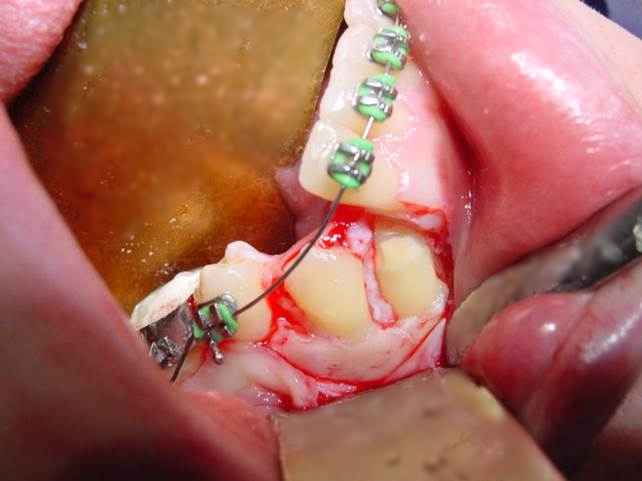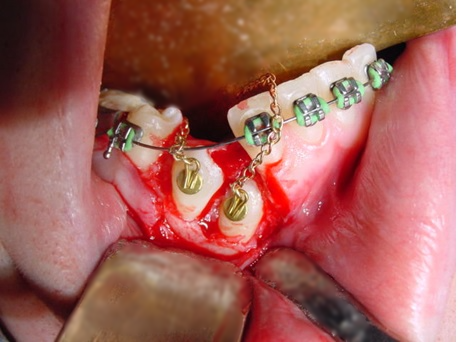Impacted Canines
An impacted tooth simply means that it has not erupted into function. The upper canine/maxillary cuspid (upper eyetooth) is the second most common tooth to become impacted after wisdom teeth. The canine tooth is a critical tooth in the dental arch and plays an important role in the bite and aesthetics. The cuspid teeth are very strong biting teeth and have the longest roots of any human teeth. They are usually the first teeth that touch when your jaws close together so they guide the rest of the teeth into the proper biting relationship.
Normally, the maxillary cuspid teeth are the last of the “front” teeth to erupt into place. They usually come into place around age 13 and cause any space left between the upper front teeth to close tighter together. Theories are that the the canine follows the path of eruption of the lateral incsior and if someting goes wrong there the canine tooth gets impacted. One of the treatment stratgies for this is to attach a chain to the tooth and pull it doen into the arch. 80% of these impacted eyeteeth are located on the palatal (roof of the mouth) side of the dental arch. The remaining impacted can be approached from the front of the arch.
What Happen’s If The Eye Tooth Will Not Erupt When Proper Space Is Available?
In cases where the eyeteeth does not erupt spontaneously, the orthodontist and oral surgeon work in collaboraton to get these unerupted canine to erupt. The most common scenario involves the orthodontist placing braces on the teeth A space will be opened to provide room for the impacted canine tooth to be moved into its proper position in the dental arch. If the baby eyetooth has not fallen out already, it is usually left in place until the space for the adult eyetooth is ready. Once the space is ready, the orthodontist will refer the patient to the oral surgeon to have the impacted eyetooth exposed and bracketed.
A surgical procedure will be performed in the surgeon’s office or in hospital, the gum on top of the impacted tooth will be elevted and possibly some bone removed to expose the hidden tooth underneath. Once the tooth is exposed, the oral surgeon will bond an orthodontic bracket to the exposed tooth. The bracket will have a miniature gold chain attached to it. The oral surgeon will guide the chain back to the orthodontic arch wire where it will be temporarily attached. Sometimes the surgeon will leave the exposed impacted tooth completely uncovered by suturing the gum up high above the tooth or making a window in the gum covering the tooth (on selected cases located on the roof of the mouth). Most of the time, the gum will be returned to its original location and sutured back with only the chain remaining visible as it exits a small hole in the gum.
Shortly after surgery (1-14 days) the patient will return to the orthodontist. A rubber band will be attached to the chain to put a light pulling force on the impacted tooth. This will begin the process of moving the tooth into its proper place in the dental arch. This is a carefully controlled, slow process that may take 9-12 months to complete.
These basic principals can be applied to any impacted tooth in the mouth. It occasioally happens in the lower jaw and the lower canines will be attached and pulled as well.
Studies have revealed that with early identification and management of impacted canines the outcome is better. Once the general dentist identifies a potential eruption problem, the patient should be referred to the orthodontist for early evaluation. In some cases the patient will be sent to the oral surgeon before braces are even applied to the teeth. The surgeon may be asked to remove over-retained baby teeth and/or selected adult teeth.
What To Expect From Surgery To Expose & Bracket An Impacted Tooth?
The surgery to expose and bracket an impacted tooth is a procedure that is performed in the oral surgeon’s office or in hospital . The procedure is generally scheduled for 60 minutes if one tooth is being exposed and bracketed and up to 90 minutes if both sides require treatment. If the procedure only requires exposing the tooth with no bracketing, the time required will be shorter. These issues will be discussed in detail at your consultation appointment with your oral surgeon.


